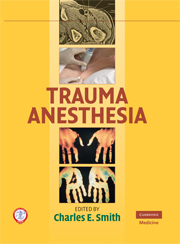Book contents
- Frontmatter
- Contents
- Foreword
- Foreword
- Preface
- Acknowledgments
- Contributors
- 1 Mechanisms and Demographics in Trauma
- 2 Trauma Airway Management
- 3 Shock Management
- 4 Establishing Vascular Access in the Trauma Patient
- 5 Monitoring the Trauma Patient
- 6 Fluid and Blood Therapy in Trauma
- 7 Massive Transfusion Protocols in Trauma Care
- 8 Blood Loss: Does It Change My Intravenous Anesthetic?
- 9 Pharmacology of Neuromuscular Blocking Agents and Their Reversal in Trauma Patients
- 10 Anesthesia Considerations for Abdominal Trauma
- 11 Head Trauma – Anesthesia Considerations and Management
- 12 Intensive Care Unit Management of Pediatric Brain Injury
- 13 Surgical Considerations for Spinal Cord Trauma
- 14 Anesthesia for Spinal Cord Trauma
- 15 Musculoskeletal Trauma
- 16 Anesthetic Considerations for Orthopedic Trauma
- 17 Cardiac and Great Vessel Trauma
- 18 Anesthesia Considerations for Cardiothoracic Trauma
- 19 Intraoperative One-Lung Ventilation for Trauma Anesthesia
- 20 Burn Injuries (Critical Care in Severe Burn Injury)
- 21 Anesthesia for Burns
- 22 Field Anesthesia and Military Injury
- 23 Eye Trauma and Anesthesia
- 24 Pediatric Trauma and Anesthesia
- 25 Trauma in the Elderly
- 26 Trauma in Pregnancy
- 27 Oral and Maxillofacial Trauma
- 28 Damage Control in Severe Trauma
- 29 Hypothermia in Trauma
- 30 ITACCS Management of Mechanical Ventilation in Critically Injured Patients
- 31 Trauma and Regional Anesthesia
- 32 Ultrasound Procedures in Trauma
- 33 Use of Echocardiography and Ultrasound in Trauma
- 34 Pharmacologic Management of Acute Pain in Trauma
- 35 Posttrauma Chronic Pain
- 36 Trauma Systems, Triage, and Transfer
- 37 Teams, Team Training, and the Role of Simulation in Trauma Training and Management
- Index
- Plate section
- References
6 - Fluid and Blood Therapy in Trauma
Published online by Cambridge University Press: 18 January 2010
- Frontmatter
- Contents
- Foreword
- Foreword
- Preface
- Acknowledgments
- Contributors
- 1 Mechanisms and Demographics in Trauma
- 2 Trauma Airway Management
- 3 Shock Management
- 4 Establishing Vascular Access in the Trauma Patient
- 5 Monitoring the Trauma Patient
- 6 Fluid and Blood Therapy in Trauma
- 7 Massive Transfusion Protocols in Trauma Care
- 8 Blood Loss: Does It Change My Intravenous Anesthetic?
- 9 Pharmacology of Neuromuscular Blocking Agents and Their Reversal in Trauma Patients
- 10 Anesthesia Considerations for Abdominal Trauma
- 11 Head Trauma – Anesthesia Considerations and Management
- 12 Intensive Care Unit Management of Pediatric Brain Injury
- 13 Surgical Considerations for Spinal Cord Trauma
- 14 Anesthesia for Spinal Cord Trauma
- 15 Musculoskeletal Trauma
- 16 Anesthetic Considerations for Orthopedic Trauma
- 17 Cardiac and Great Vessel Trauma
- 18 Anesthesia Considerations for Cardiothoracic Trauma
- 19 Intraoperative One-Lung Ventilation for Trauma Anesthesia
- 20 Burn Injuries (Critical Care in Severe Burn Injury)
- 21 Anesthesia for Burns
- 22 Field Anesthesia and Military Injury
- 23 Eye Trauma and Anesthesia
- 24 Pediatric Trauma and Anesthesia
- 25 Trauma in the Elderly
- 26 Trauma in Pregnancy
- 27 Oral and Maxillofacial Trauma
- 28 Damage Control in Severe Trauma
- 29 Hypothermia in Trauma
- 30 ITACCS Management of Mechanical Ventilation in Critically Injured Patients
- 31 Trauma and Regional Anesthesia
- 32 Ultrasound Procedures in Trauma
- 33 Use of Echocardiography and Ultrasound in Trauma
- 34 Pharmacologic Management of Acute Pain in Trauma
- 35 Posttrauma Chronic Pain
- 36 Trauma Systems, Triage, and Transfer
- 37 Teams, Team Training, and the Role of Simulation in Trauma Training and Management
- Index
- Plate section
- References
Summary
Objectives
Understand the timing, extent, and the immediate goals for the initial fluid resuscitation in trauma victims, individualized to specific patients.
Review the factors influencing choice of fluid for the initial and ongoing resuscitation.
Discuss factors influencing the decision for initiating transfusion therapy, choice of blood products, immediate and delayed risks and benefits of transfusion therapy.
Become familiar with the current state of therapies intended for the most severely injured patients, including recombinant factor VIIa and massive blood transfusion protocols.
Initial evaluation of an acutely volume-depleted trauma patient will include a primary and secondary survey according to Advanced Trauma Life Support® protocol, an estimate of blood volume deficit (Table 6.1), rate of the ongoing blood loss, and an evaluation of cardiopulmonary reserve and coexisting hepatic or renal dysfunction [1]. The overriding priority of trauma management is to maintain or restore vital organ perfusion and oxygenation above critical levels at an early stage, and to restore perfusion and oxygenation to normal levels as soon as it becomes appropriate. This is best achieved by stopping the bleeding and repleting intravascular volume. Perfusion pressure and oxygenated blood flow to vital organs are important determinants of outcome.
Management priorities in an acutely bleeding trauma patient include ventilation and oxygenation (see Chapter 2), assessment of perfusion, estimation of volume replacement requirements, establishment or verification of adequate intravenous (IV) access (see Chapter 4), measurement of blood pressure, placement of electrocardiogram (ECG), pulse oximeter and capnograph, and laboratory studies.
- Type
- Chapter
- Information
- Trauma Anesthesia , pp. 101 - 120Publisher: Cambridge University PressPrint publication year: 2008



